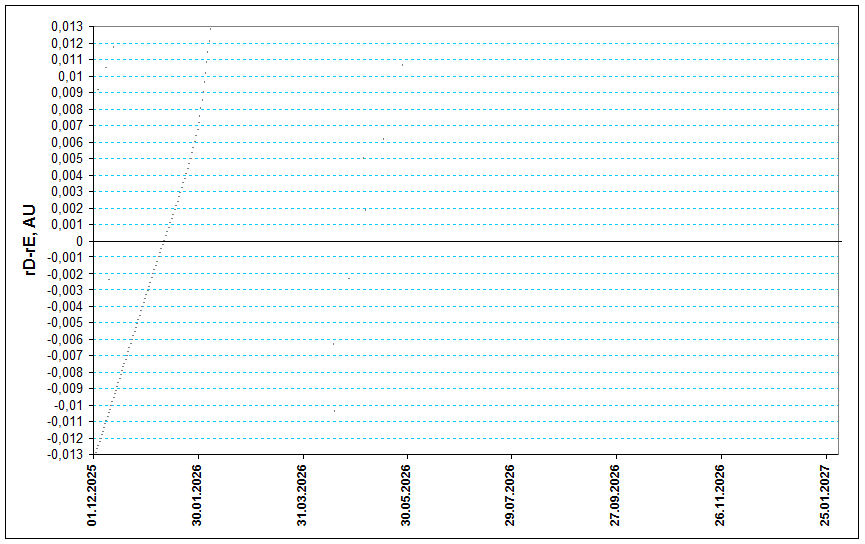255P-ids 2026: prediction of activity
to the list of predictions

Fig. 1. Space-temporal projection of 255P-ids trails parts onto their minimal distance passages in 2026 (correspondence between colours of the particles and their ejection velocities can be seen here).
At 12:46 UT on January 1 2026 some weak appearance of meteor activity from the 1897 trail of the comet 255P/Levy is possible. As computation results show this trail passes at 0.00296 AU from the Earth, ejection velocity of particles is quite high - 42.7 m/s while density is rather low and equals to 21.9% of that for 1 revolution Leonids trail. Such parameters mean that probabity of any detectable activity is low but still this case is recommended to check with observations. Computed radiant is RA=329.9°, Dec=+59.6°.

Fig. 2. The Earth as seen from coming 255P-ids meteors (RA=329.9°, Dec=+59.6°) during the expected maximum time of outburst from 1897 trail at 12:46 UT on January 1.
In case the outburst takes place at the given time it will be best visible in the asian part of Eurasia as well as on the most northern part of North America and Greenland. Unfortunately the almost full Moon in the phase of 88%% will create significant troubles for observation.
References
1. "Comet's dust 2.0" program by S. Shanov and S. Dubrovsky. [Used for orbital computations.]
2. E. Lyytinen, T. van Flandern "Predicting the strength of Leonid outbursts", 2000, Earth, Moon, and Planets, P. 149-166.
3. Jenniskens P. Meteor showers and their parent comets, 2006, 780 p. 4. Kasuo Kinoshita, http://jcometobs.web.fc2.com/ [Orbital elements of the comet 255P/Levy]
5. Hewgill G. Xearth 1.1.0 (Software program), 2003.
References
1. "Comet's dust 2.0" program by S. Shanov and S. Dubrovsky. [Used for orbital computations.]
2. E. Lyytinen, T. van Flandern "Predicting the strength of Leonid outbursts", 2000, Earth, Moon, and Planets, P. 149-166.
3. Jenniskens P. Meteor showers and their parent comets, 2006, 780 p. 4. Kasuo Kinoshita, http://jcometobs.web.fc2.com/ [Orbital elements of the comet 255P/Levy]
5. Hewgill G. Xearth 1.1.0 (Software program), 2003.